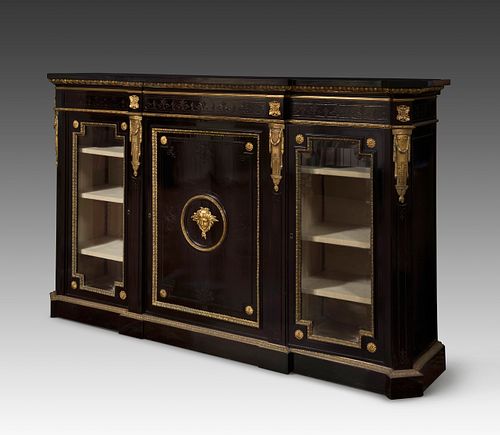Napoleon III style credenza, last third of the nineteenth century. Ebonized wood, black marble top and bronze of later period. Presents scratches an
Lot 92
About Seller
Setdart Auction House
Carrer Aragó 346
Barcelona
Spain
Setdart Subastas was born in 2004 and is currently the first online art auction in Spain with solidity, prestige and reliability guaranteed by our more than 60,000 users. Setdart has a young, dynamic and enterprising team ready to successfully manage the purchase and sale of art works through custom...Read more
Categories
Estimate:
EUR€3,000 - EUR€4,000
$3,225.81 - $4,301.08
Absentee vs Live bid
Two ways to bid:
- Leave a max absentee bid and the platform will bid on your behalf up to your maximum bid during the live auction.
- Bid live during the auction and your bids will be submitted real-time to the auctioneer.
Bid Increments
| Price | Bid Increment |
|---|---|
| EUR€0 | EUR€10 |
| EUR€200 | EUR€25 |
| EUR€500 | EUR€50 |
| EUR€1,000 | EUR€100 |
| EUR€3,000 | EUR€200 |
| EUR€5,000 | EUR€500 |
| EUR€10,000 | EUR€1,000 |
| EUR€20,000 | EUR€2,000 |
| EUR€50,000 | EUR€5,000 |
About Auction
By Setdart Auction House
Nov 10, 2021
Set Reminder
2021-11-10 08:00:00
2021-11-10 08:00:00
America/New_York
Bidsquare
Bidsquare : 19th & 20th Century paintings and Decorative Arts
https://www.bidsquare.com/auctions/setdart-auction-house/19th-20th-century-paintings-and-decorative-arts-7800
Setdart Auction House sofia@setdart.com
Setdart Auction House sofia@setdart.com
- Lot Description
Napoleon III style credenza, last third of the nineteenth century. Ebonized wood, black marble top and bronze of later period. Presents scratches and piequettes. Measurements: 119 x 206 x 53,5 cm. Furniture made of ebonized wood with bronze appliques that, for its aesthetic characteristics, recalls the Napoleon III style. The credenza is defined by a design inspired by classical forms, which are adapted to an ornamental pattern of straight lines and protruding edges, in which the play of volumes and materials provides a great expressiveness that breaks with the rigidity of the most purist classicism. The furniture is structured in three streets, delimited by rectangular sections that are inspired by the pilasters as an architectural element. These are defined by bronze sconces, located in the upper area, of classicist aesthetics as they are decorated with garlands. In the center there is a wooden body that serves as a door, while the sides are conceived as a showcase, revealing the interior of the cabinet. One of the most characteristic elements of the decoration is based on the various bronze fixtures, which use classical motifs, such as the aforementioned garlands and rosettes. In addition, it is worth mentioning that, in the center of the main body, there is an applique that simulates the head of Medusa, inspired by the sculpture "Medusa Rondanini", which is currently in the Glyptotheque of Munich. As for the rest of the ornamentation of the nuble, it is completed with symmetrically carved elements, located in the perimeter areas of the piece of furniture, either the door that makes up the central body, or the upper area of the credenza.
- Shipping Info
-
In-house shipping available. Please inquire at admin@setdart.com.
-
- Buyer's Premium



 EUR
EUR CAD
CAD AUD
AUD GBP
GBP MXN
MXN HKD
HKD CNY
CNY MYR
MYR SEK
SEK SGD
SGD CHF
CHF THB
THB

















